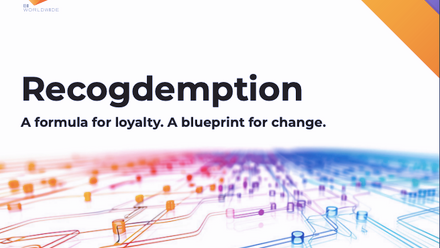How to leverage the intersection of recognition, redemption, and retention
Recognition is often the spark that ignites motivation in employee engagement. But what happens after that spark? According to BI WORLDWIDE’s latest insights report, Recogdemption, the answer lies in a critical, often overlooked moment - redemption.
Redemption is more than just the act of claiming a reward. It’s the feeling of recognition, a tangible affirmation that says, “You matter here.” And when done right, it doesn’t just reinforce positive behaviour, it transforms it.
Recent research from BI WORLDWIDE explores this phenomenon in depth, coining the term recogdemption to describe the powerful intersection of recognition, redemption, and retention. The findings reveal that redemption is more than a reward mechanism, it’s a cultural signal, a behavioural driver, and a strategic opportunity for organisations looking to deepen engagement.
The redemption effect
Redemption is defined in the report as the moment when an employee exchanges recognition points for something personally meaningful, be it merchandise, experiences, or development opportunities. But this isn’t just about transactional value. It’s about emotional resonance.
When employees redeem a reward, they’re not just receiving a product or service. They’re internalising a message of appreciation. This emotional reinforcement boosts morale, strengthens loyalty, and motivates continued performance. It also creates visibility, when others see recognition in action, and the culture of appreciation spreads.
Spenders vs savers and understanding redemption behaviour
Not all employees engage with rewards in the same way. They can be identified into two dominant profiles:
- Spenders: These employees redeem frequently (typically every six months) after receiving around 5-6 recognitions.
- Savers: These individuals hold out longer, redeeming every 12-24 months, usually after 8-12 recognitions.
Understanding these profiles is essential for designing effective recognition reward strategies. For spenders, the key is maintaining a steady cadence of recognition and ensuring the rewards catalogue remains fresh and relevant for them.
For savers, it’s about gently nudging them toward redemption through wishlists, goal proximity messaging, and personalised communications that make the reward feel within reach.
The first redemption
The first redemption is crucial, setting the tone for everything that follows. Employees typically engage with the rewards platform five times before making their first redemption. But once they do, two out of three return within the next three months.
This moment is critical. It marks the transition from passive participation to active engagement. It’s the point where recognition becomes real, and the employee begins to see themselves as part of a culture that values their contribution.
The $200 tipping point
So, what drives that first redemption? The data points to a psychological and strategic sweet spot of $200 (about £150). This figure represents the intersection of aspiration and attainability. Rewards under $200 are essential for triggering early redemption and building momentum.
But higher-value rewards, considered to be those above the $200 mark, carry disproportionate emotional weight. They’re more memorable, more meaningful, and more likely to drive long-term engagement.
In fact, while 83% of reward orders are under $200, they account for just 40% of total order value. The remaining 17% (those above $200) make up a staggering 60% of total value. The message from this couldn’t be clearer. Aspirational rewards matter.
Designing for redemption
If you want to utilise the full power of redemption, organisations need to be intentional in their programme design. That means:
- Offering a balanced reward catalogue: Include a wide selection of desirable options under $200 to encourage early redemption, alongside aspirational rewards that inspire long-term performance.
- Segmenting your audience: Tailor communications and strategies for spenders and savers based on their recognition and redemption behaviours.
- Encouraging first redemptions: Use nudges, wishlists, and targeted messaging to prompt early engagement with the rewards platform.
- Tracking and optimising: Monitor redemption patterns and adjust your offering to reflect employee preferences and emerging trends.
Why redemption can set the tone
Redemption isn’t just a personal milestone, it’s a cultural one. When employees see their peers redeeming meaningful rewards, it reinforces the value of the recognition programme and potentially pushes them to redeem their own points. It creates a ripple effect, encouraging others to engage, give recognition, and strive for their own moments of reward.
And the impact doesn’t stop there. There is a strong correlation between redemption behaviour and employee tenure. High-frequency redeemers are more engaged, more likely to give recognition themselves, and significantly more likely to stay with the organisation long-term.
The bigger picture
Redemption is one side of the recogdemption triangle, alongside recognition and retention. But it’s the side that often turns intention into action. It’s where appreciation becomes visible, where motivation becomes momentum, and where culture becomes contagious.
We all know that employee expectations are evolving, and where engagement is more critical than ever, redemption offers a powerful lever for change. It’s not just about giving rewards, it’s about giving meaning to an individual, and a team.
And when that meaning is felt, shared, and celebrated, the results speak for themselves.
Explore the full report to uncover how recognition, redemption, and retention work together to drive lasting impact.
Supplied by REBA Associate Member, BI WORLDWIDE
BI WORLDWIDE is a global engagement agency delivering measurable results for clients through inspirational employee and channel reward and recognition solutions.








